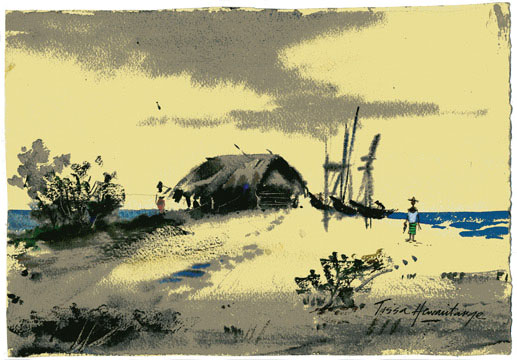The combination of wet and dry techniques
by Tissa Hewavitarane
It is difficult to use the techniques of painting on a wet background
or just the technique of painting on a dry background in any given
painting. Usually both are used simultaneously to achieve the desired
effects of each, capturing the fusion of tones on the one hand and the
precision of a dry brush stroke on the other. The only problem is that
these two techniques demand completely different drying times between
applications. If the base is wet, the newly applied paint will spread
and merge. If the base is solid, the brush strokes will appear definite
and precise.
The wet background allows effects of atmosphere, vaugue shades,
merging areas, gradations and the merging and blending of colour. The
extent to which an added colour will spread depends upon the degree of
wetness of the background controlling and enabling the painter to work
with great precision in the area where the colour is being applied. The
wetness is controlled with absorbent paper, with a sponge, a dry brush
or by the natural evaporation of the water.
 To observe the dry times for each coat of paint, wait for the paper
to dry a little. If you paint while the paper is still soaking wet the
colour will run and blend completely while the back ground is still wet,
but not soaked a darker colour could be added. To observe the dry times for each coat of paint, wait for the paper
to dry a little. If you paint while the paper is still soaking wet the
colour will run and blend completely while the back ground is still wet,
but not soaked a darker colour could be added.
With a dryer base, the form of the brush stroke can be controlled,
much better controlling the flow of the paint on the paper improves as
the paper dries. It is important to remember that you can't paint light
tones over dark tones with water colour paints. It must always be the
other way around.
There is nothing more exhilarating than dropping rich colour on to
wet and watching things happen. Wet-into-wet is a bit of a misnomer
because if you do actually drop wet paint on to a wet surface you then
get two lots of water and the result is weak, runny and out of control.
Apart from describing the main pitfalls, there's no way one can really
explain the technique.
You just have to experience it and experiment yourself. Try it out
with just one colour first, and be prepared to waste a few sheets of
paper until you achieve your target. A word of warning, never use
wet-into-wet for foregrounds, they at least, should be crisp and sharp
otherwise it will look as if you are wearing the wrong glasses.
Do practise this technique although it probably won't come off at
first. Wet-into-wet is the most spontaneous and exciting, but too much
of it can be vague and dull. A good example of the use of wet-in-wet is
shown the painting I have done here. Thick paint is used on the hut to
get a dark tone and of dark patches on the tree and ground.
The eye is always to human figure in any landscape, and their
inclusion can turn an ordinary subject to a striking picture. The
fishing boats give a dramatic impression with two tiny figures in the
boat and a man standing on a side.
These are used to give life, movement and scale to the picture.
Depending on the nature of the day the reflected light can be either a
very important of your painting use of strong colours is the most
expressive element in the artist's vocabulary.
Observe the colours I have applied on the painting. I have expressed
the colours what I have felt and understood of the nature. You will
observe a bluish yellow light appear on the sky, with a wash of light
orange and earth also light with same colour.
The painting also composed of grey raging from palest tint to the
deepest grey brown and greens, giving an impression of consistent
harmonious light. The first thing to say about dry brush technique is no
to over do it. It is useful to produce textures and to suggest detail.
The paint is put on with the brush quickly skimming over the surface
of the paper, leaving the colour only on the ridges of the irregular
surface.
The colour and the brush it self is kept very dry and appears on the
paper with hundred of gaps which allows the paper or under painting to
show through.
The dry brush has many uses - to suggest the bright shimmer of the
sun on water, the texture of pebbles on the shore, the rough bark on a
tree trunk or the weathered surface of a plaster wall. Do practise and
experiment to discover all the many textures available. Push, stroke, or
even pat the brush on the paper. Try holding the brush almost parallel
to the paper so that the hairs barely graze it.
Once you can control different drying times, it is possible to
combine both techniques. With constant practice this combination will
yield astonishing results that are much more simple to create than would
appear on first impression.
The effect of a blend on wet can be applied next to the effect of a
painting on dry demonstrate the depth of a landscape, textures of
objects, volume and so on. An Watercolour techniques have their strength
and weaknesses.
Wash for example is the most positive way of indicating shapes. Its
strength lies in its simplicity using wet-into-wet technique. It is the
most spontaneous and exciting and delightful experience. It is wet and
vibrant and in varying degrees and great way to get your feet wet in the
medium and experience a unique sensation to transparent watercolour. |

